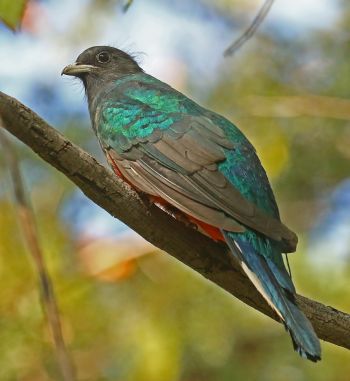Sbarnhardt (talk | contribs) (Update Clements to Oct23) |
|||
| (13 intermediate revisions by 8 users not shown) | |||
| Line 1: | Line 1: | ||
| − | {{ | + | [[File:Eared-Quetzal_First-Image_GLTEPK.jpg|thumb|550px|right|Photo © by {{user|Glen+Tepke|Glen Tepke}}<br /> [[Cave Creek Canyon]], Coronado National Forest, Maricopa County, [[Arizona]], [[USA]], 6 October 2020]] |
| − | ;Euptilotis neoxenus | + | '''Alternative names: Eared Trogon''' |
| − | + | ;[[:Category:Euptilotis|Euptilotis]] neoxenus | |
==Identification== | ==Identification== | ||
| − | + | [[File:Eared-Quetzal_Side-View_GLTEPK.jpg|thumb|350px|right|Side view<br />Photo © by {{user|Glen+Tepke|Glen Tepke}}<br /> [[Cave Creek Canyon]], Coronado National Forest, Maricopa County, [[Arizona]], [[USA]]. 6 October 2020]] | |
| − | + | *Turquoise blue upperparts | |
| + | *Emerald green breast | ||
| + | *Red belly and underparts | ||
| + | *Black head | ||
| + | *Iridescent wing coverts | ||
| + | *Black blue tail with white underneath | ||
| + | *Dark bill | ||
==Distribution== | ==Distribution== | ||
| + | One of the few [[:Category:Trogonidae|trogons]] found in the [[United States]], where it is a rare visitor to southeast [[Arizona]]. The core of its range is in the highland forests of [[Mexico]]´s Sierra Madre Occidental. | ||
==Taxonomy== | ==Taxonomy== | ||
| + | Also known as Eared Trogon (for instance, by Sibley and Monroe). More recent authorities have preferred Eared Quetzal in order to recognise this genus's similarity to the [[:Category:Pharomachrus|''Pharomachrus'']] quetzals. | ||
| + | |||
| + | This is a [[Dictionary_M-O#M|monotypic]] species<sup>[[#References|[1]]]</sup>. | ||
| + | |||
==Habitat== | ==Habitat== | ||
| + | Montane forest. | ||
==Behaviour== | ==Behaviour== | ||
| + | They nest in tree cavities, lined with wood chips. The clutch consists of 2 pale blue eggs. | ||
| + | ==References== | ||
| + | #{{Ref-Clements6thOct23}}#Southeastern Arizona Bird Observatory | ||
| + | {{ref}} | ||
==External Links== | ==External Links== | ||
| − | + | {{GSearch|"Euptilotis neoxenus" {{!}} "Eared Quetzal" {{!}} "Eared Trogon"}} | |
| − | [[Category:Birds]] [[Category: | + | {{GS-checked}}1 |
| + | <br /> | ||
| + | <br /> | ||
| + | [[Category:Birds]] [[Category:Euptilotis]] | ||
Latest revision as of 15:18, 27 November 2023

Cave Creek Canyon, Coronado National Forest, Maricopa County, Arizona, USA, 6 October 2020
Alternative names: Eared Trogon
- Euptilotis neoxenus
Identification

Photo © by Glen Tepke
Cave Creek Canyon, Coronado National Forest, Maricopa County, Arizona, USA. 6 October 2020
- Turquoise blue upperparts
- Emerald green breast
- Red belly and underparts
- Black head
- Iridescent wing coverts
- Black blue tail with white underneath
- Dark bill
Distribution
One of the few trogons found in the United States, where it is a rare visitor to southeast Arizona. The core of its range is in the highland forests of Mexico´s Sierra Madre Occidental.
Taxonomy
Also known as Eared Trogon (for instance, by Sibley and Monroe). More recent authorities have preferred Eared Quetzal in order to recognise this genus's similarity to the Pharomachrus quetzals.
This is a monotypic species[1].
Habitat
Montane forest.
Behaviour
They nest in tree cavities, lined with wood chips. The clutch consists of 2 pale blue eggs.
References
- Clements, J. F., P. C. Rasmussen, T. S. Schulenberg, M. J. Iliff, T. A. Fredericks, J. A. Gerbracht, D. Lepage, A. Spencer, S. M. Billerman, B. L. Sullivan, and C. L. Wood. 2023. The eBird/Clements checklist of Birds of the World: v2023. Downloaded from https://www.birds.cornell.edu/clementschecklist/download/
- Southeastern Arizona Bird Observatory
Recommended Citation
- BirdForum Opus contributors. (2024) Eared Quetzal. In: BirdForum, the forum for wild birds and birding. Retrieved 23 May 2024 from https://www.birdforum.net/opus/Eared_Quetzal
External Links
GSearch checked for 2020 platform.1



